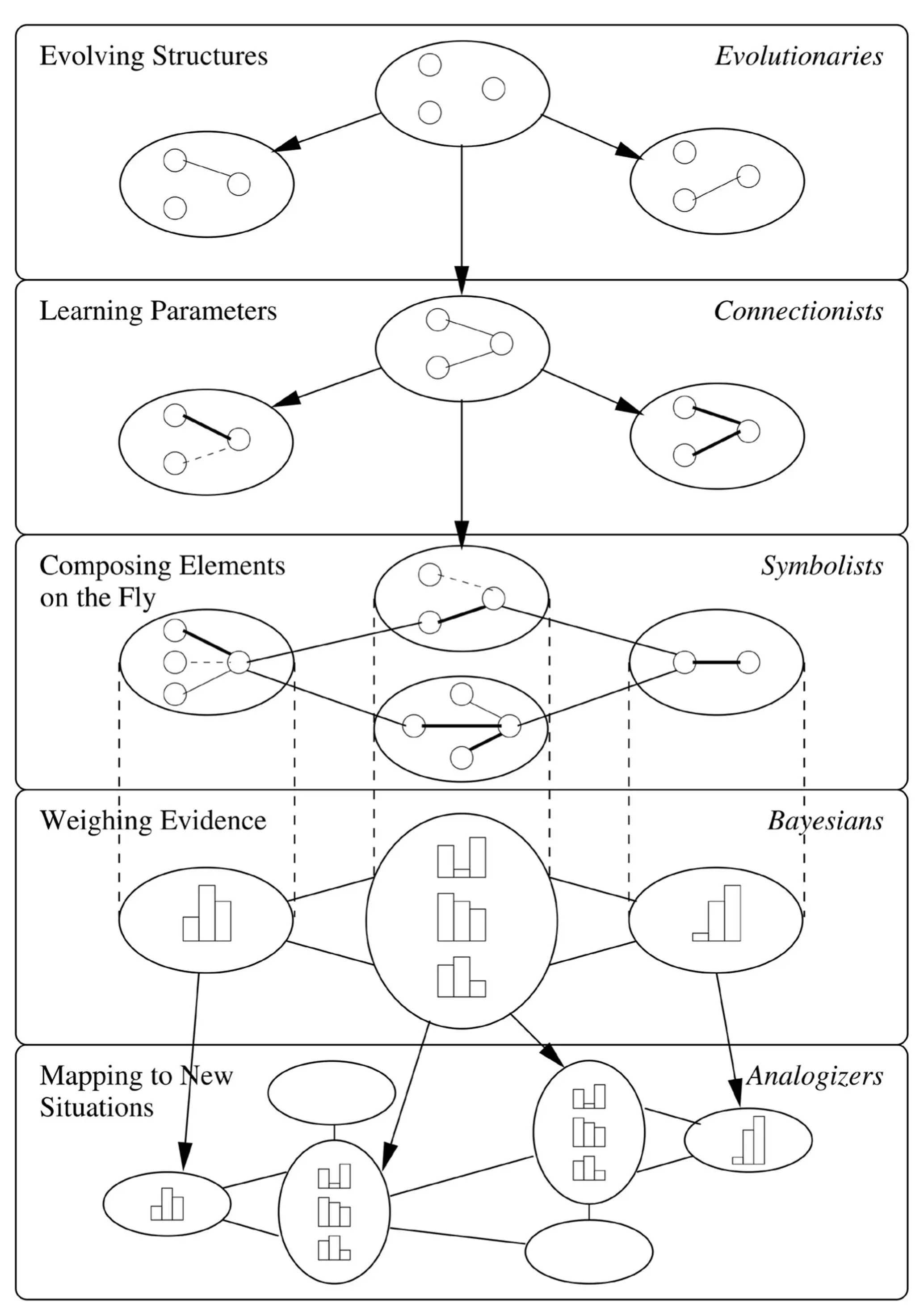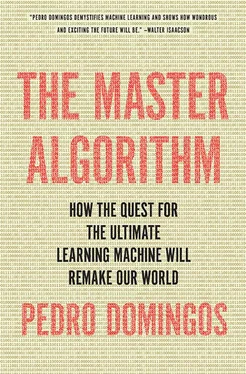For connectionists, learning is what the brain does, and so what we need to do is reverse engineer it. The brain learns by adjusting the strengths of connections between neurons, and the crucial problem is figuring out which connections are to blame for which errors and changing them accordingly. The connectionists’ master algorithm is backpropagation, which compares a system’s output with the desired one and then successively changes the connections in layer after layer of neurons so as to bring the output closer to what it should be.
Evolutionaries believe that the mother of all learning is natural selection. If it made us, it can make anything, and all we need to do is simulate it on the computer. The key problem that evolutionaries solve is learning structure: not just adjusting parameters, like backpropagation does, but creating the brain that those adjustments can then fine-tune. The evolutionaries’ master algorithm is genetic programming, which mates and evolves computer programs in the same way that nature mates and evolves organisms.
Bayesians are concerned above all with uncertainty. All learned knowledge is uncertain, and learning itself is a form of uncertain inference. The problem then becomes how to deal with noisy, incomplete, and even contradictory information without falling apart. The solution is probabilistic inference, and the master algorithm is Bayes’ theorem and its derivates. Bayes’ theorem tells us how to incorporate new evidence into our beliefs, and probabilistic inference algorithms do that as efficiently as possible.
For analogizers, the key to learning is recognizing similarities between situations and thereby inferring other similarities. If two patients have similar symptoms, perhaps they have the same disease. The key problem is judging how similar two things are. The analogizers’ master algorithm is the support vector machine, which figures out which experiences to remember and how to combine them to make new predictions.
Each tribe’s solution to its central problem is a brilliant, hard-won advance. But the true Master Algorithm must solve all five problems, not just one. For example, to cure cancer we need to understand the metabolic networks in the cell: which genes regulate which others, which chemical reactions the resulting proteins control, and how adding a new molecule to the mix would affect the network. It would be silly to try to learn all of this from scratch, ignoring all the knowledge that biologists have painstakingly accumulated over the decades. Symbolists know how to combine this knowledge with data from DNA sequencers, gene expression microarrays, and so on, to produce results that you couldn’t get with either alone. But the knowledge we obtain by inverse deduction is purely qualitative; we need to learn not just who interacts with whom, but how much, and backpropagation can do that. Nevertheless, both inverse deduction and backpropagation would be lost in space without some basic structure on which to hang the interactions and parameters they find, and genetic programming can discover it. At this point, if we had complete knowledge of the metabolism and all the data relevant to a given patient, we could figure out a treatment for her. But in reality the information we have is always very incomplete, and even incorrect in places; we need to make headway despite that, and that’s what probabilistic inference is for. In the hardest cases, the patient’s cancer looks very different from previous ones, and all our learned knowledge fails. Similarity-based algorithms can save the day by seeing analogies between superficially very different situations, zeroing in on their essential similarities and ignoring the rest.
In this book we will synthesize a single algorithm will all these capabilities:

Our quest will take us across the territory of each of the five tribes. The border crossings, where they meet, negotiate and skirmish, will be the trickiest part of the journey. Each tribe has a different piece of the puzzle, which we must gather. Machine learners, like all scientists, resemble the blind men and the elephant: one feels the trunk and thinks it’s a snake, another leans against the leg and thinks it’s a tree, yet another touches the tusk and thinks it’s a bull. Our aim is to touch each part without jumping to conclusions; and once we’ve touched all of them, we will try to picture the whole elephant. It’s far from obvious how to combine all the pieces into one solution-impossible, according to some-but this is what we will do.
The algorithm we’ll arrive at is not yet the Master Algorithm, for reasons we’ll see, but it’s the closest anyone has come. And we’ll gather enough riches along the way to make Croesus envious. Nevertheless, this book is only part one of the Master Algorithm saga. Part two’s protagonist is you, dear reader. Your mission, should you choose to accept it, is to go the rest of the way and bring back the prize. I will be your humble guide in part one, from here to the edge of the known world. Do I hear you protest that you don’t know enough, or algorithms are not your forte? Fear not. Computer science is still young, and unlike in physics or biology, you don’t need a PhD to start a revolution. (Just ask Bill Gates, Messrs. Sergey Brin and Larry Page, or Mark Zuckerberg.) Insight and persistence are what counts.
Are you ready? Our journey begins with a visit to the symbolists, the tribe with the oldest roots.
CHAPTER THREE: Hume’s Problem of Induction
Are you a rationalist or an empiricist?
Rationalists believe that the senses deceive and that logical reasoning is the only sure path to knowledge. Empiricists believe that all reasoning is fallible and that knowledge must come from observation and experimentation. The French are rationalists; the Anglo-Saxons (as the French call them) are empiricists. Pundits, lawyers, and mathematicians are rationalists; journalists, doctors, and scientists are empiricists. Murder, She Wrote is a rationalist TV crime show; CSI: Crime Scene Investigation is an empiricist one. In computer science, theorists and knowledge engineers are rationalists; hackers and machine learners are empiricists.
The rationalist likes to plan everything in advance before making the first move. The empiricist prefers to try things and see how they turn out. I don’t know if there’s a gene for rationalism or one for empiricism, but looking at my computer scientist colleagues, I’ve observed time and again that they are almost like personality traits: some people are rationalistic to the core and could never have been otherwise; and others are empiricist through and through, and that’s what they’ll always be. The two sides can converse with each other and sometimes draw on each other’s results, but they can understand each other only so much. Deep down each believes that what the other does is secondary, and not very interesting.
Rationalists and empiricists have probably been around since the dawn of Homo sapiens . Before setting out on a hunt, Caveman Bob spent a long time sitting in his cave figuring out where the game would be. In the meantime, Cavewoman Alice was out systematically surveying the territory. Since both kinds are still with us, it’s probably safe to say that neither approach was better. You might think that machine learning is the final triumph of the empiricists, but the truth is more subtle, as we’ll soon see.
Rationalism versus empiricism is a favorite question of philosophers. Plato was an early rationalist, and Aristotle an early empiricist. But the debate really took off during the Enlightenment, with a trio of great thinkers on each side: Descartes, Spinoza, and Leibniz were the leading rationalists; Locke, Berkeley, and Hume were their empiricist counterparts. Trusting in their powers of reasoning, the rationalists concocted theories of the universe that-to put it gently-did not stand the test of time, but they also invented fundamental mathematical techniques like calculus and analytical geometry. The empiricists were altogether more practical, and their influence is everywhere from the scientific method to the Constitution of the United States.
Читать дальше













